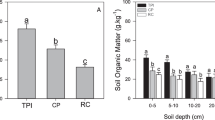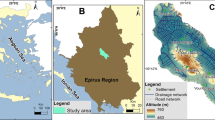Abstract
Purpose
Forest ecosystem acts as a significant sink and source of elements; however, the dynamics of trace elements (TEs) in soils of boreal zone are still poorly characterized. Data on relationships of TEs, major elements (MEs), soil properties, and parent rock geochemistry in boreal forest of Northeast Asia are scarce. Therefore, the objectives of this study were to evaluate the origination of TEs in forest soils and identify soil properties and ecosystem processes controlling accumulation and profile distribution of TEs.
Materials and methods
Dystric Cambisols and underlying parent rocks have been sampled within hilly landscape covered by Gmelin larch (Larix gmelinii (Rupr.) Rupr.) forests in Amur region (Russia). This paper considers 10-selected soil characteristics, total concentrations of 19 TEs, and 10 MEs measured by ICP-MS and RFA analysis. Factor analysis has been employed to highlight underlying relationships hidden in a complex data of element concentration and soil characteristics. Origination of TEs was assessed by using an enrichment factor (EF) considering concentration of TEs in soil in comparison to underlying parent rocks using Ti as a reference element.
Results and discussion
A group of biophile Zn, Mo, Sn, and Pb were enriched in the upper soil horizon, and depleted in mineral compared to parent rocks. Beryllium, Sc, Cr, Cu, Ga, Ge, Ta, Th, and U were depleted in both horizons. Ni and Cs show highest enrichment in both studied soil horizons. Frequently occurring forest fires affect soil characteristics and TEs dynamic only in the upper part of soil profile. Factor analysis revealed potential effect of exchangeable Na and soil pH on accumulation of the elements in the upper horizon, as a result of ash deposition by fire.
Conclusions
The studied TEs primarily originate from underlying parent rocks. Accumulation versus leaching of TEs in Dystric Cambisols might be element specific and affected by fire-derived ash. Our work shows that the upper horizon of forest soils could act as a significant sink of group of TEs. Therefore, long-term observations of TEs dynamic in soil profiles are needed to elucidate biogeochemical cycles in frequently burned forests of Northeast Asia. The present study for the first time has established an important wide data set of TEs concentration in Dystric Cambisols of natural boreal forests in the Russian Far East.




Similar content being viewed by others
References
Amur Center for Hydrometeorology and Environmental Monitoring (2015) Meteorological characteristics of Norsk Meteorological Station between 1989 and 2011 years. Blagoveschensk, p 4
Ballesta RJ, Bueno PC, Rubi JAM, Giménez RG (2010) Pedo-geochemical baseline content levels and soil quality reference values of trace elements in soils from the Mediterranean (Castilla La Mancha, Spain). Cent Eur J Geosci 2:441–454
Bergkvist B, Folkeson L, Berggren D (1989) Fluxes of Cu, Zn, Pb, Cd, Cr, and Ni in temperate forest ecosystems. Water Air Soil Pollut 47:217–286
Blaser P, Zimmermann S, Luster J, Shotyk W (2000) Critical examination of trace element enrichments and depletions in soils: As, Cr, Cu, Ni, Pb, and Zn in Swiss forest soils. Sci Total Environ 249:257–280
Bryanin SV, Makoto K (2017) Fire-derived charcoal affects fine root vitality in a post-fire Gmelin larch forest: field evidence. Plant Soil 416:409–418
Bryanin SV, Sorokina OA (2015) The first data on the vertical REE distribution in taiga soils of the Russian Far East. Dokl Earth Sci 464:1053–1057
Bryanin S, Abramova E, Makoto K (2018) Fire-derived charcoal might promote fine root decomposition in boreal forests. Soil Biol Biochem 116:1–3
Certini G (2005) Effects of fire on properties of forest soils: a review. Oecologia 143:1–10
Escudey M, Arancibia-Miranda N, Pizarro C, Antilén M (2015) Effect of ash from forest fires on leaching in volcanic soils. Catena 135:383–392
Galloway JN, Cowling EB (2002) Reactive nitrogen and the world: 200 years of change. AMBIO A J Hum Environ 31:64–71
Kabata-Pendias A (2011) Trace elements in soils and plants. In: Kabata-Pendias A (ed) Taylor & Francis Group, 4th edn. Boca Raton, USA, p 548
Kabata-Pendias A, Szteke B (2015) Trace elements in abiotic and biotic environments. CRC Press, Cambridge p 468
Liodakis S, Tsoukala M, Katsigiannis G (2009) Laboratory study of leaching properties of Mediterranean forest species ashes. Water Air Soil Pollut 203:99–107
Makoto K, Nemilostiv YP, Zyryanova OA et al (2007) Regeneration after forest fires in mixed conifer broad-leaved forests of the Amur region in Far Eastern Russia : the relationship between species specific traits against fire and recent fire regimes. Eurasian J For Res 10–1:51–58
Makoto K, Hirobe M, DeLuca TH et al (2011) Effects of fire-derived charcoal on soil properties and seedling regeneration in a recently burned Larix gmelinii/Pinus sylvestris forest. J Soils Sediments 11:1317–1322
Makoto K, Shibata H, Kim YS, Satomura T, Takagi K, Nomura M, Satoh F, Koike T (2012) Contribution of charcoal to short-term nutrient dynamics after surface fire in the humus layer of a dwarf bamboo-dominated forest. Biol Fertil Soils 48:569–577
Mandre M (2006) Influence of wood ash on soil chemical composition and biochemical parameters of young Scots pine. Proc Est Acad Sci Biol Ecol 55:91–107
Neary DG, Klopatek CC, DeBano LF, Ffolliott PF (1999) Fire effects on belowground sustainability: a review and synthesis. For Ecol Manag 122:51–71
Omil B, Piñeiro V, Merino A (2007) Trace elements in soils and plants in temperate forest plantations subjected to single and multiple applications of mixed wood ash. Sci Total Environ 381:157–168
Pansu M, Gautheyrou J (2006) Handbook of soil analysis. Springer Berlin Heidelberg, Berlin
Pereira P, Úbeda X, D a M (2012) Fire severity effects on ash chemical composition and water-extractable elements. Geoderma 191:105–114
R Development Core Team (2017) R: a language and environment for statistical computing. Vienna, Austria. https://www.R-project.org/
Rafferty B, Brennan M, Dawson D, Dowding D (2000) Mechanisms of 137Cs migration in coniferous forest soils. J Environ Radioact 48:131–143
Revelle W (2018) psych: Procedures for psychological, psychometric, and personality research.Northwestern University, Evanston, USA. https://CRAN.R-project.org/package=psych. Version = 1.8.4.
Sharma S (1996) Applied multivariate techniques. John Wiley & Sons, New York
Sorokin AA, Kotov AB, Kudryashov NM, Kovach VP (2015) First evidence of Ediacaran magmatism in the geological history of the Mamyn Terrane of the Central Asian fold belt. Russ J Pacific Geol 9:399–410
Sorokin AA, Kudryashov NM, Kotov AB, Kovach VP (2017) Age and tectonic setting of the early Paleozoic magmatism of the Mamyn Terrane, Central Asian Orogenic Belt, Russia. J Asian Earth Sci 144:22–39
Sterckeman T, Douay F, Baize D, Fourrier H, Proix N, Schvartz C (2006) Trace elements in soils developed in sedimentary materials from Northern France. Geoderma 136:912–929
Taylor S, McLennan S (1995) The geochemical evolution of the continental crust. Rev Geophys 33:241–265
Timofeeva YO, Kosheleva Y, Semal V, Burdukovskii M (2018) Origin, baseline contents, and vertical distribution of selected trace lithophile elements in soils from nature reserves, Russian Far East. J Soils Sediments 18:968–982
Tume P, Bech J, Longan L, Tume L, Reverter F, Sepulveda B (2006) Trace elements in natural surface soils in Sant Climent (Catalonia, Spain). Ecol Eng 27:145–152
Tyler G (2004) Vertical distribution of major, minor, and rare elements in a Haplic Podzol. Geoderma 119:277–290
Tyler G (2005) Changes in the concentrations of major, minor and rare-earth elements during leaf senescence and decomposition in a Fagus sylvatica forest. For Ecol Manag 206:167–177
Tyler G, Olsson T (2001) Plant uptake of major and minor mineral elements as influenced by soil acidity and liming. Plant Soil 230:307–321
Tyler G, Olsson T (2002) Conditions related to solubility of rare and minor elements in forest soils. J Plant Nutr Soil Sci 165:594–601
Vega FA, Covelo EF, Andrade ML, Marcet P (2004) Relationships between heavy metals content and soil properties in minesoils. Anal Chim Acta 524:141–150
Wang X, Cheng G, Zhong X, Li M-H (2009) Trace elements in sub-alpine forest soils on the eastern edge of the Tibetan Plateau, China. Environ Geol 58:635–643
Weiss D, Shotyk W, Rieley J, Page S, Gloor M, Reese S, Martinez-Cortizas A (2002) The geochemistry of major and selected trace elements in a forested peat bog, Kalimantan, SE Asia, and its implications for past atmospheric dust deposition. Geochim Cosmochim Acta 66:2307–2323
WRB IWG (2015) World reference base for soil resources 2014 International soil classification system for naming soils and creating legends for soil maps. World Soil Resources Reports No. 106. FAO, Rome
Zhang XP, Deng W, Yang XM (2002) The background concentrations of 13 soil trace elements and their relationships to parent materials and vegetation in Xizang (Tibet), China. J Asian Earth Sci 21:167–174
Zharikova EA (2017) Geochemical characterization of soils of the eastern coast of the Northern Sakhalin Lowland. Eurasian Soil Sci 50:34–41
Author information
Authors and Affiliations
Corresponding author
Additional information
Responsible editor: Yongfu Li
Electronic supplementary material
ESM 1
(DOCX 21 kb)
Rights and permissions
About this article
Cite this article
Bryanin, S.V., Sorokina, O.A. Effect of soil properties and environmental factors on chemical compositions of forest soils in the Russian Far East. J Soils Sediments 19, 1130–1138 (2019). https://doi.org/10.1007/s11368-018-2141-x
Received:
Accepted:
Published:
Issue Date:
DOI: https://doi.org/10.1007/s11368-018-2141-x




